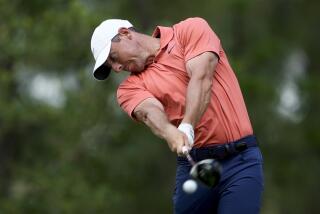These Days, U.S. Open Is Wide Open
- Share via
ROCHESTER, N.Y. — Why is a U.S. Open like the French Revolution?
Well, it’s an aristocratic enterprise that keeps getting overrun by the peasants. It’s Communism. Anarchy. The proletariat rules. You feel like coming up and saying, “Who’s in charge here anyway? Anybody?”
The most bootless thing I can think of is posting a gaming line on a U.S. Open. Form goes right out the window in handicapping this thing. How do you handicap a lottery? It’s like picking your mother out of a fuzzy crowd shot. You’re better off sticking a hat-pin in a program.
It didn’t used to be this way. It used to be, years ago, there were only about a half-dozen players who could win an Open. When Bobby Jones lost one, it was news. The way things are today, it would be news if he won one. Andy North wins Opens these days--and very little else. Scott Simpson. Lou Graham. All the greats.
You get the feeling some guy in torn jeans is going to come into town on a Greyhound bus, change shoes in the parking lot, borrow a one-iron, buy a box of balls in a drugstore--and go out and win a U.S. Open, wearing a mask.
I’m a monarchist myself when it comes to sports. I like stars. “Unknown Wins Open” is a headline that works maybe once every other decade. But not every other year.
But before you despair and get ready for a mystery guest Open winner--a Mark Wiebe Open, Dennis Trixler’s finest hour, be advised that the last time the Open was held here at Rochester’s Oak Hill, a lot of us thought we were looking at another world-class fluke, the crowning of an all-time nobody, this chunky, chatty, happy-go-lucky young Mexican with a little loopy, fadey swing and a bagful of taped clubs, shoes with a cleat missing and socks that glowed in the dark.
Fellow by the name of Lee Buck Trevino.
He went out in 1968 and shot four rounds in the 60s, the first time that was done in an Open. He beat Nicklaus and Palmer, he put Bert Yancey in a trance--it was the first tournament Trevino ever won--and it was clear nobody ever explained to him how difficult it was to hit a golf ball straight.
Well, it turned out Lee Buck knew how to hit a golf ball straight as well as anyone who ever did it--any Bobby Jones, Ben Hogan, Lord Nelson, Jack Nicklaus, Arnold Palmer, Walter Hagen, Sam Snead or Harry Vardon. Twenty-seven victories--and two British Opens--later, we found out we were looking at history not humbug.
The Open at Rochester wasn’t the first one I ever saw--that would have been Hogan’s first Open victory at Riviera in 1948--but it was one of the vintage ones.
You get to rate Opens like Bourbon kings or vintage wines. Some make history. Others make a mess. I can rate them in the order of their memorability, seen or unseen. The best:
1948--Hogan won, didn’t he? His first of four. It was memorable because it was his first and because he broke the Open scoring record by five shots and the golf czar, Joe Dye, decided if he ever held an Open in California again, he would have to bring his own rough and maybe lions around a green. Hogan would have shot 276 on the slopes of Everest that year.
1960--Palmer won, didn’t he? What more do you want of an Open? It was Arnold’s only win and someday the gods of golf will have to answer for that but any tournament A.P. wins with a final-round 65 should hang in the Louvre. It makes our pantheon unanimously.
1930--Bobby Jones won his fourth. Only one other amateur, Johnny Goodman in 1933, was ever to win even one after that, but a golf gallery without a Jones Open is like the Vatican without a Raphael.
1939--This is the only Open that makes the good-news draw because of a negative but this was the tournament in Philadelphia where Sam Snead became Sam Snead, the symbol of runaway bad luck. The greatest golfer never to win an Open self-destructed on the last hole at Spring Mill in the most spectacular blow-up--for a great player--in the annals of the game, the greatest immolation in the history of golf. The glare in the sky has been visible for 50 years.
1958--Tommy Bolt won, didn’t he? For old Thunder not to have won an Open would have been an injustice of the order of Snead’s not. No one else ever swung at a ball with the sweetness and purity of Bolt or Snead.
1965--Gary Player, who should have won three, won his only Open at Bellerive. He four-wooded it to death to go with his two Masters, two PGAs and three British Opens.
1939, again--Byron Nelson, who won 19 tournaments in one year, won his only Open and needed Snead’s blowup to do it. The gods are not entirely malicious. They could have let some one-putt from Altoona beat Snead. For once, they didn’t.
1972--Jack Nicklaus won his third but Nicklaus against Pebble Beach was a classic matchup on the order of Dempsey-Tunney, Koufax vs. Willie Mays, St. George and the dragon. Nicklaus was the only guy who didn’t stagger off Pebble that year, hollow-eyed and choking and wondering why he hadn’t gone into some other line of work.
And now for the worst:
1955--Hogan lost, didn’t he? To Jack Fleck, a club pro out of Davenport, Iowa. Joe Dye grew rough you could hide elephants in. One guy, Porky Oliver, lost a free drop. It wasn’t a tournament, it was a safari.
1966--Oh, dear! Palmer lost. Not only that, he threw away a seven-shot lead in nine holes. Golfers rank it with that other San Francisco earthquake. Fifty million Americans went to bed that night feeling as if they had just lost the Open.
1947--Snead had an 18-inch putt to win. His opponent challenged the assumption that Snead was away and should putt first. Snead was. He putted. He missed. Lew Worsham won the Open by a shot. Snead was second, as he was in five U.S. Opens
1970--The Brit, Tony Jacklin, won by seven shots. He was not that good. When you win an Open by seven shots, the chances are the golf course was an unplayable lie. It was.
1987--San Francisco’s Olympic Club was the guy in the black hat to the last. The club that had its chance to give Ben Hogan his fifth and Arnold Palmer his second Open, stopped Tom Watson from getting his second. It gets the place in history of the Titanic’s iceberg.
And now, on to Mark Wiebe. Or Jay Don Blake. Jose Maria Olazabal?
More to Read
Go beyond the scoreboard
Get the latest on L.A.'s teams in the daily Sports Report newsletter.
You may occasionally receive promotional content from the Los Angeles Times.










